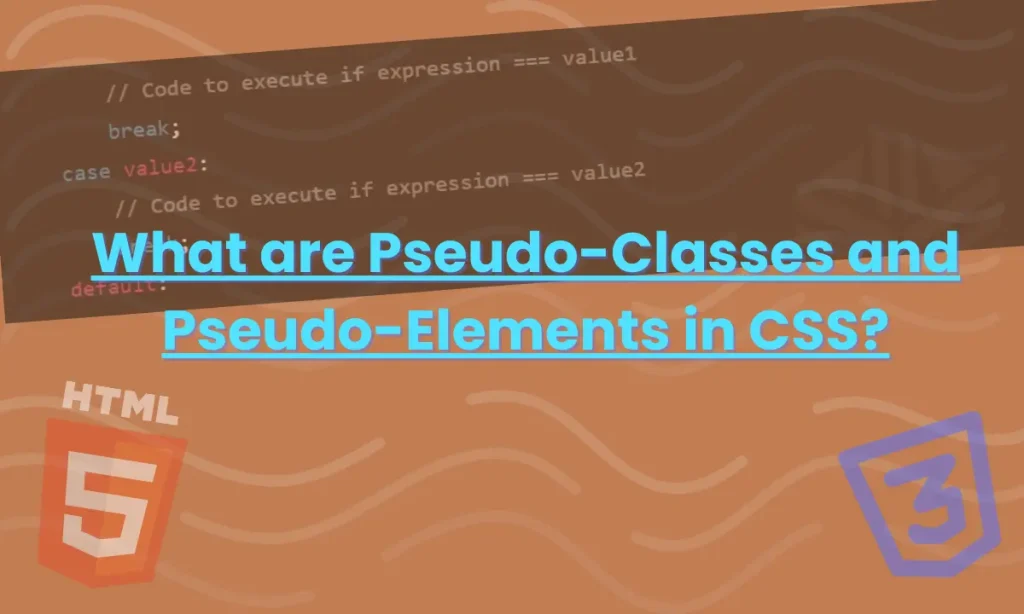What are Pseudo-Classes and Pseudo-Elements in CSS – CSS is essential for creating attractive, functional websites. As you deepen your understanding, you will come across pseudo-classes and pseudo-elements, which are invaluable tools for targeting and styling elements in specific states or positions. They help you create more dynamic, responsive, and interactive websites with minimal changes to the HTML.
In this article, we will explore pseudo-classes and pseudo-elements, examine their role in CSS, and learn how to use them effectively.
What Are Pseudo-Classes in CSS?
In CSS, a pseudo-class allows you to style an element based on a specific state or condition that cannot be easily expressed through simple selectors. It acts as a filter that selects elements only when they match a particular state, like when a user hovers over a button or when an element is the first or last child of its parent.
For example, the
pseudo-class targets an element when a user hovers their mouse over it:
button:hover {
background-color: #4CAF50; /* Change button color on hover */
}
Pseudo-classes are extremely useful for making your website more interactive and dynamic without needing extra HTML code.
Common Pseudo-Classes Explained
Here are some of the most commonly used pseudo-classes in CSS:
The :hover pseudo-class applies styles when a user hovers over an element. It’s most commonly used for links, buttons, or any clickable elements.
a:hover {
color: red; /* Changes the text color to red when hovered */
}
The :active pseudo-class targets an element when it is in the active state, like when a user is clicking on a button.
button:active {
background-color: darkgreen; /* Changes the button color when clicked */
}
This pseudo-class targets an element that is the first child of its parent.
p:first-child {
font-weight: bold; /* Makes the first paragraph bold */
}
Targets the last child element of its parent:
p:last-child {
font-style: italic; /* Makes the last paragraph italic */
}
()
This pseudo-class allows you to target specific elements based on their position among siblings:
li:nth-child(2) {
color: blue; /* Colors the second item in a list blue */
}
What Are Pseudo-Elements in CSS?
A pseudo-element in CSS allows you to style a specific part of an element, as if it were a separate element. Unlike pseudo-classes, which apply styles based on states, pseudo-elements are used to style parts of the element’s content, like the first letter, line, or adding content before or after an element.
Pseudo-elements use double colons (::) to differentiate from pseudo-classes.
Common Pseudo-Elements Explained
::before
The ::before pseudo-element allows you to insert content before the content of an element.
h1::before {
content: "★ "; /* Adds a star before every heading */
}
::after
Similar to ::before, the ::after pseudo-element inserts content after an element.
h1::after {
content: " ★"; /* Adds a star after every heading */
}
::first-line
This pseudo-element targets the first line of an element’s content, often used to style text.
p::first-line {
color: green; /* Changes the color of the first line to green */
}
::first-letter
This pseudo-element targets the first letter of a block-level element.
p::first-letter {
font-size: 200%; /* Makes the first letter larger */
}
Difference : Pseudo-Classes and Pseudo-Elements
Though they may seem similar, pseudo-classes and pseudo-elements serve different purposes. Pseudo-classes target elements based on their state or position, while pseudo-elements target specific parts of an element’s content.
Pseudo-class example:
p:hover {
color: blue;
}
Pseudo-element example:
p::first-letter {
font-size: 150%;
}
Best Practices for Using Pseudo-Classes and Pseudo-Elements
- Use them sparingly: Overusing pseudo-classes or pseudo-elements can complicate your CSS and make it harder to maintain.
- Combine effectively: For more complex designs, combine pseudo-classes and pseudo-elements to achieve intricate results.
- Test for browser compatibility: Always check that your pseudo-classes and pseudo-elements work in all major browsers.
Limitations and Browser Compatibility
Not all browsers support all pseudo-classes and pseudo-elements equally. It’s important to test and provide fallbacks for unsupported features, especially for older browsers.
Conclusion
Why Pseudo-Classes and Pseudo-Elements Matter in Modern Web Design
Pseudo-classes and pseudo-elements allow developers to style elements more dynamically and efficiently. By leveraging these tools, you can create interactive, user-friendly websites without excessive HTML or JavaScript. As you continue to explore the power of CSS, mastering pseudo-classes and pseudo-elements will become a crucial skill.
FAQs
What is the difference between a pseudo-class and a pseudo-element?
A pseudo-class targets elements based on their state, while a pseudo-element targets parts of an element’s content.
Can I use multiple pseudo-classes on the same element?
Yes, you can chain pseudo-classes for more specific targeting (e.g., a:hover:active).
Do pseudo-classes and pseudo-elements work on all browsers?
Most modern browsers support them, but some older browsers may require fallbacks.
Is it better to use pseudo-classes or JavaScript for interactivity?
Pseudo-classes are lightweight and efficient for basic interactions, but JavaScript is better for more complex functionality.
Can I use pseudo-elements for images?
Pseudo-elements mainly target text content, but you can insert images using::before or ::after with the content property.








